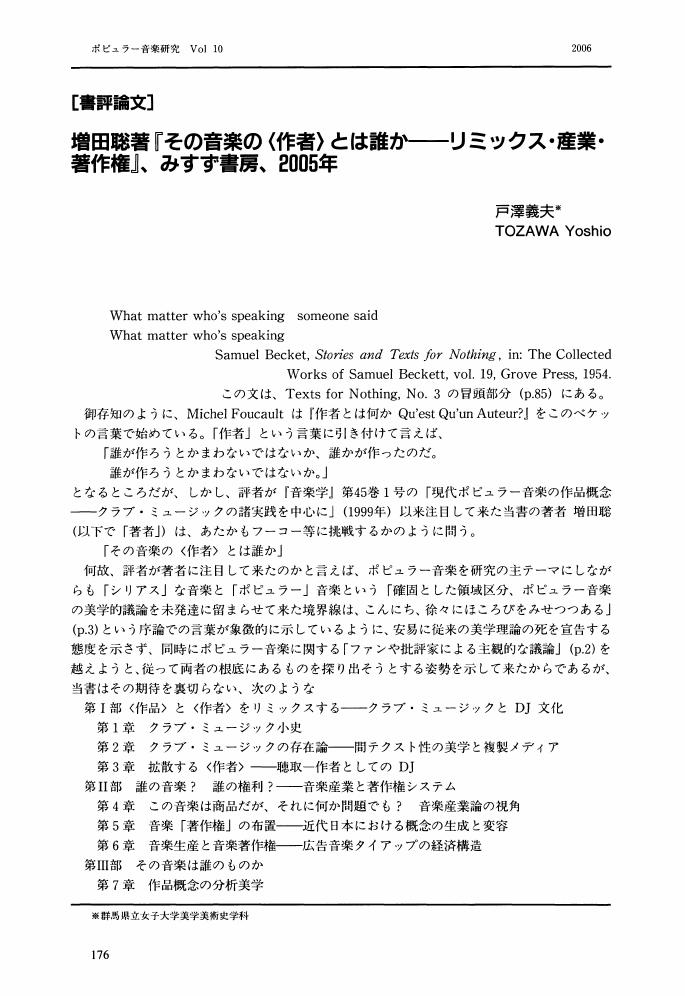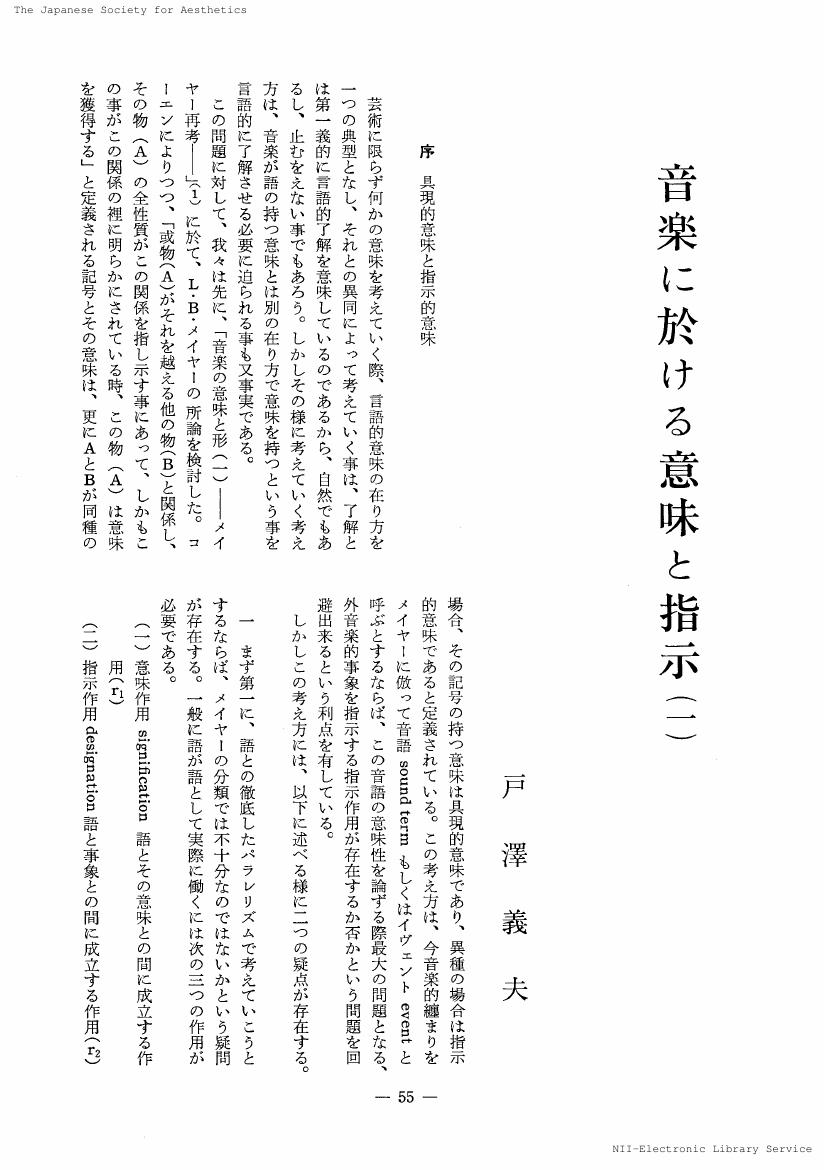- 著者
- 戸澤 義夫
- 出版者
- 日本ポピュラー音楽学会
- 雑誌
- ポピュラー音楽研究 (ISSN:13439251)
- 巻号頁・発行日
- vol.10, pp.176-180, 2006 (Released:2009-10-29)
1 0 0 0 OA 音楽に於ける意味と指示 (二)
- 著者
- 戸澤 義夫
- 出版者
- 美学会
- 雑誌
- 美学 (ISSN:05200962)
- 巻号頁・発行日
- vol.29, no.1, pp.54-65, 1978-06-30 (Released:2017-05-22)
When we think about a general problem of the meaning, we must take into account three following functions, all of which must operate at the same time as far as a word can stand as a word in language ; F_1 (Designation)-a function to designate a referent ; F_2 (Signification)-a function to signify something which is not necessarily equal to the referent ; F_3 (Syntactic Construction)-a function to construct a sentence. According to G. Blocker, among these functions there are very interesting phenomena. In one direction F_1 has a tendency to absorb F_2 into itself, and in another direction F_2 does F_1. But at the moment this absorption seems to be accomplished in either direction, the language itself can no more operate as a language. Because, in the first case, meaning, something signified, becomes a kind of real object which cannot be discriminated from a physical object ; in the second case, the referent seems to exist without any signification-nothing else but an illusion. This attraction and repulsion between F_1 and F_2 compells us to recorrect the formalistic view of musical meaning, which tries to drive both F_1 and F_2 out of consideration and to insist as if the musical meaning could exist simple as one kind of F_3-F_3 functions here as an activiation of F_2 through the intrusion or deviation of an different sound term in a direction-oriented context (L. B. Meyer). When we think it impossible to return to the simple referentialistic view which cannot explain the raison d'etre of music, we arrive at N. Goodman's concept, "exemplification", which can explain how a work which exemplifies something can posess not only the function of F_3 but also those of F_1 and F_2. And if we were right up to this point, we must also turn our concerns from semantics to pragmatics and beginn to make it clear what the implicit or underground referent is in music (Ch. Hubig).
1 0 0 0 OA 音楽に於ける意味と指示(一)
- 著者
- 戸澤 義夫
- 出版者
- 美学会
- 雑誌
- 美学 (ISSN:05200962)
- 巻号頁・発行日
- vol.28, no.4, pp.55-67, 1978-03-30 (Released:2017-05-22)
1 0 0 0 『音樂利害』における「唱歌」の位置(2)
- 著者
- 戸澤 義夫
- 出版者
- 群馬県立女子大学
- 雑誌
- 群馬県立女子大学紀要 (ISSN:02859432)
- 巻号頁・発行日
- no.26, pp.91-166, 2005-02
1 0 0 0 美と藝術の価値論的基礎づけ
本年度は6回の研究会を開催した。昨年度は報告を提出したあとの3月にも研究会を催したが、今年度分に限って言えば、それぞれの研究報告者とその主題は次の如くである。先ず、尼ヶ崎彬は舞踊を対象とし「藝術的価値と身体」について論じた。その際、舞踊批評において用いられる評言を手掛かりとして、訓練された踊り手の身体において認められる独特な藝術的価値を明らかにした。小田部胤久は18世紀のドイツ美学、すなわちまだ価値の概念が十分に術語化していなかった時代の美学思想のなかに潜在している価値論を、再構成することを試みた。長野順子は「生の強度」という観点から、バ-クからカントをへてニーチェに至る崇高概念を研究した。そして、とくにこの種の美的範疇に伴う性差のイメージを、理論書のテクストから抽出して、そこに新しい光を当てた。加藤好光は、西田幾多郎の述語論理と場所の概念に注目しつつ、これを生命科学や生気論哲学によって再記述することによって、「美的体験の生命関係学的基礎づけ」を試みた。大石昌史は、価値の再評価を行ったニーチェのニヒリズムの哲学において、絶対的肯定によって美的価値が創造されるという思想を捉え、その理論をあとづけた。伊藤るみ子はP・キヴィーの論考を手掛かりとして、音楽における作品の演奏の関係、特に「演奏のauthenticity」の問題を考察した。この他、代表者佐々木が価値概念についての原理的考察を著書の一部として公表するなど、各研究分担者の独自の研究もあるが、全体の研究成果のうち、公表可能な段階に達したものを集めて研究成果の報告書を編んだ。

